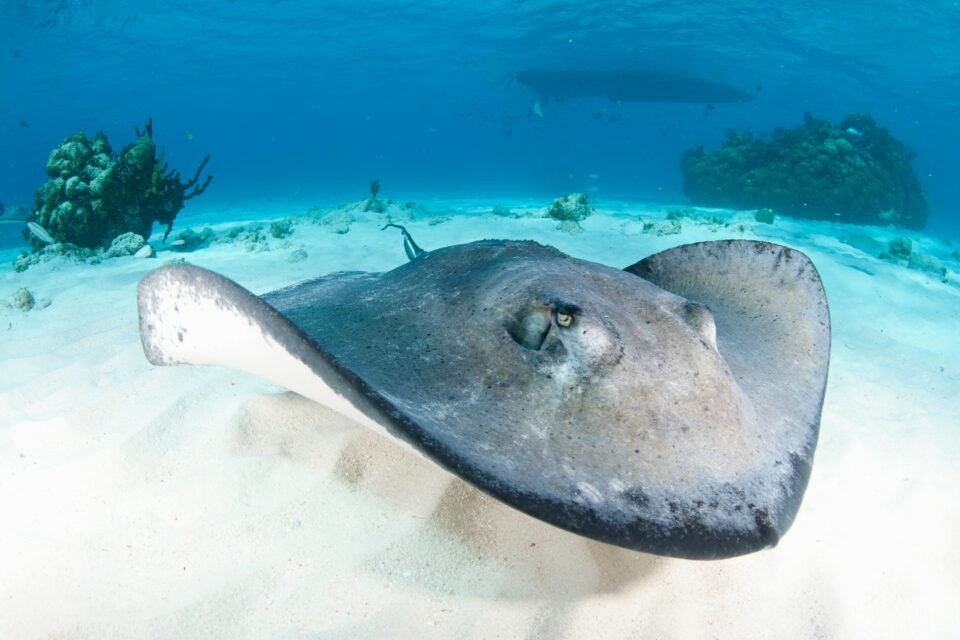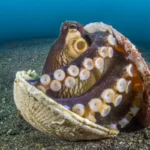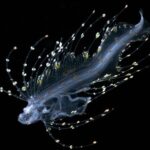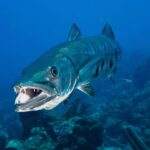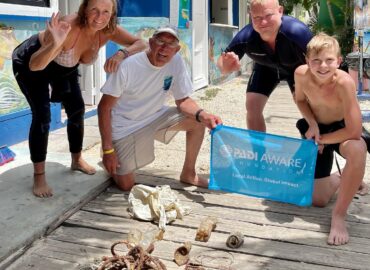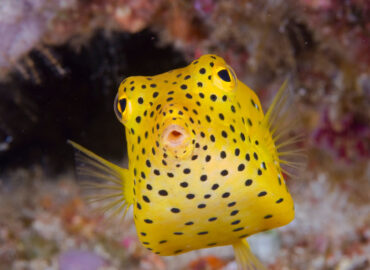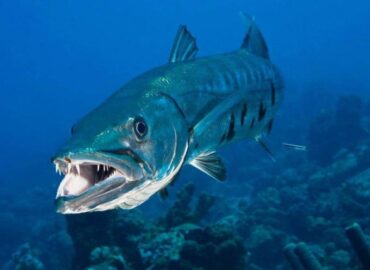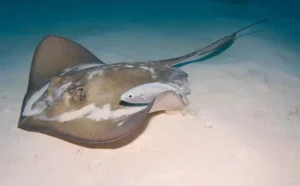
Stingrays are more related to sharks than they let on; in fact they belong to their own class: the Chondrichthyes, i.e. animals with a cartilaginous skeleton. In reality, after the appearance of this class about 400 million years ago, the rays detached very early from the sharks, returning to the order of the Mylobatoidei.
The term stingray indicates a huge variety of animals, for simplicity we will focus on the main characteristics of the most common stingrays that can be encountered while snorkeling and diving in the Mediterranean Sea and in tropical sea.Viva Shallow
When we think of the stingray we always think of a large disc with a tail and a very dangerous sting! Indeed, the peculiar characteristic of these animals is precisely the shape of their body: they are discoidal with a width greater than about a third compared to their length and perfectly adapted to life benthic, that is on the bottom.
Evolution has led these animals to significantly develop their pectoral fins precisely because they are used as a propelling organ. This has led to the enlargement of the same becoming one with the rest of the body and allowing for graceful and very rapid movements, perfect for a life as a camouflage hunter!
Animal’s body shape always says a lot about their habits and lifestyle: the propulsive organ of the shark is the tail and for this reason it has developed this elongated physiognomy; unlike the stingray which has preferred a different type of propulsion.
How to recognize a stingray?
In addition to the unique body sahpe, there are features that immediately catch the eye :
The nose in most species is perfectly incorporated into the body. The back compared to the belly has no particular curvature and is mostly flat, we can observe the presence of the eyes and immediately , behind them, the spiracles .
The spiracles are openings with a respiratory function that allow the entry of water and oxygen into the body then expelled from the gills without the animal having to swim. This special adaptation is typical of animals that live in ambush on the bottom; in fact they are much larger than animals that lead a pelagic life (in the open sea), precisely because they can introduce water into the gills directly from the mouth and therefore the function of the spiracle is less accentuated.
The mouth is in the ventral part of the body, and is provided with a very robust set of teeth: they are not pointed but rounded close to each other to create a compact plate. Why this? Because stingrays are durophages, they feed of prey with a robust calcareous shell or skeleton and therefore need a powerful bite to be able to break them.
The other fins such as dorsal, pelvic and anal are often totally regressed, modified or very small. The dorsal fin, when present, appears in a rearward position, approximately above the pelvic fins and before the tail.
The coloring is very different depending on the type of seabed that the animal chooses as home. The most common colors are light to dark brown, yellowish, gray, and mottled in a variety of colors.
The dimensions are very varied: from a few cm up to 2-3 meters in width in the largest stingrays.
The tail is long and thin but very robust. It has one or more clearly visible quills depending on the species.

Where does the stingray live and what does it eat?
Stingrays are found in all the tropical seas of the world: from the Pacific to the Atlantic coasts, but also in some temperate areas. Most of the species are benthic, i.e. they live on the bottom, both in predominantly coralline areas and in sandy bottoms, however preferring sand to rocky bottoms. Some species, on the other hand, live in the middle of oceanic vegetation, called kelp. Their particular flattened shape and their color make them able to blend in in an exemplary way. Thanks also to the expanded pectoral fins, they cover their back with sand and “disappear” for most of the day, with the exception of their eyes, always alert and attentive to the movements around them.
Stingrays are very skilled and fast predators: they mostly hunt animals such as crustaceans, molluscs and small fish at night.
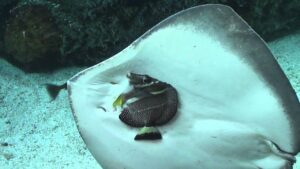
Unlike what one might think, they do not kill the preys with their poisonous sting but rather with their robust bite. The power of their bite is precisely given by the particular shape of the teeth, moreover they manage to immobilize the prey by forming a sort of umbrella with their disc around it, not allowing it any way out of the mouth. They are not particularly social animals, but with the abundance of food they can create even very numerous groups around the “banquets”.
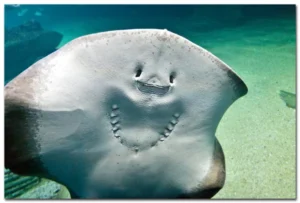
The extra gear of the stingray
What strategies have stingrays developed to have such an effective evolution? Stingrays, like all other animals, use the five senses to interact with their surroundings: sight, smell, touch, hearing and smell. They are chondrichthyes and this means that these senses have been developed in a very effective way, guaranteeing a 360-degree perception of visible and non-visible reality. Not only that though… Stingrays, like their cousins sharks, have a sixth sense, namely electroreception.
This very particular sense allows you to perceive the electric fields produced by any living body. They manage to do this thanks to particular cells filled with electroconductive jelly located just under the skin and in particular on the face. These cells are precisely called Ampullae of Lorenzini.
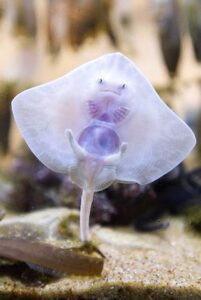
How does the stingray reproduce?
Male stingrays, like sharks, possess two penises called pterygopods, resulting from the transformation of the pelvic fins. This makes it possible to distinguish males from females in adult specimens. When males are sexually mature, these organs calcify and become ready for mating. Evolution has brought this particular development to ensure the survival of the species: if a pterygopodium get damaged, they can still have the opportunity to mate. Mating takes place by hormonal recall by the female via chemical signals dissolved in the water.
The favorable period of reproduction of the breeds goes from spring to summer and, subsequently, a three-month gestation takes place before giving birth to 2 to 4 babies. Depending on the species, females have one birth every year or every two.
The stingrays make few babies and try to ensure their survival by giving birth to them already of large dimensions and above all capable of hunting autonomously. The female always gives birth in shallow waters or in places sheltered in the vegetation precisely to ensure a lower presence of predators. Once the chicks have been born, there is no parental care and the females immediately separate from them.
Gestation lasts three months and the mother produces eggs very rich in yolk which ensure the growth of the fetus up to half of its development. From then on, the mother herself will feed them by ingestion, skin transmission or to particular structures connected to her intestine; precisely for this reason the stingrays are aplacental viviparous animals. Their life cycle is therefore very complex, just like in sharks and at the moment there is no precise data on the length of their life in the wild or at what age they are sexually ready to reproduce.
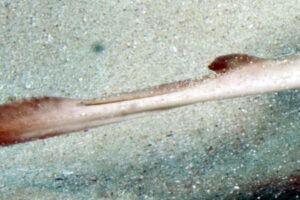
This much feared tail… What if it should sting us?
First of all, let us always remember that animals should never be touched or fed in any way.
The stingray stings to defend itself not to attack us, being an animal that lives well camouflaged on the bottom it can happen that we do not notice it and that our presence can scare the animal. The stingray is not considered a dangerous animal for humans, all the attacks have turned out to be accidents and the fatal ones have been very rare. You can simply prevent these unpleasant accidents by never touching anything on the bottom and, especially for snorkeling, always stay close to the water and never stand on the coral reef or sand. By following this simple rule you will be able to admire the stingray in total safety and pleasure.
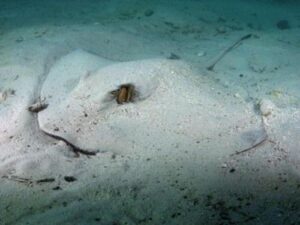
In the tail there are one or two spines and at their root there are two venom glands which secrete a substance capable of killing cells, also causing muscle contractions. The action of this process is necrotizing and this is combined with the possibility of even serious bacterial infections. If we are stung by its sting, the first thing to do is to wet the affected part with plenty of hot water (sweet or salty) between 42°C and 45°C and, if it should bleed, press firmly on the wound. In any case, you must go to a doctor and follow the first aid procedures. The puncture itself, although painful, is not lethal. The poison injected and the infection must be treated immediately.
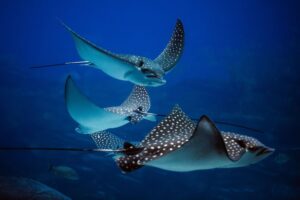
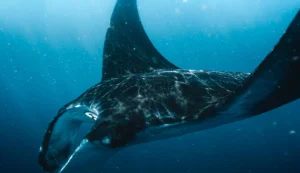
I am a stingray not a manta or a eagle ray!
The stingray is often confused with manta rays and eagle rays, however the difference is very evident: stingrays live on the bottom of the sea while mantas or eagle rays usually move from a place to another.
Another method to distinguish them is by observing the position of the mouth: in stingrays it is ventral so if it is on the bottom we will not be able to notice it, while for manta rays and sea eagles it is in an apical position and in any case clearly visible on the snout.
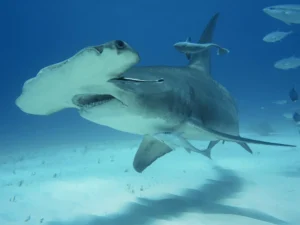
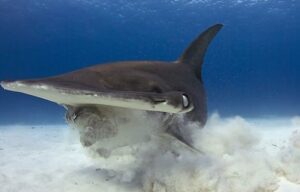
Who are the enemies of the stingrays?
The main enemy of the stingray is the great hammerhead shark which is fond of these animals. Thanks to his special hammer rich in sensory cells and Ampollae of Lorenzini he manages to capture the presence of the stingray perfectly camouflaged under the sand. The stingray can defend itself with its poisonous sting and with its ability of camuflage, thanks to its colour, its shape or any other strategy, to blend in with the surrounding environment.Viva Shallow
What stingrays can we easily meet?
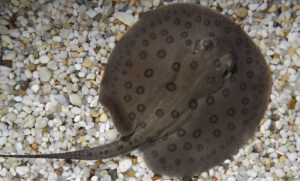
The most famous and well-known stingray family is called Dasyatidae which includes freshwater and saltwater species.
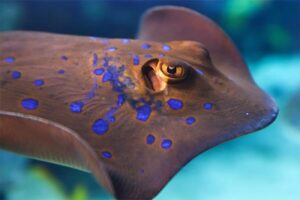
The most famous tropical reef stingray is the blue spotted stingray (Taeniura lymma).
It is so called because its back is yellowish and spotted with small electric blue dots, with two lateral blue stripes. It is a small stingray with a diameter of about 35 cm. Another distinctive feature is to have big orange eyes that are very attentive to every slightest movement.
We can find it in the tropical waters of the Indian Ocean and the Pacific Ocean but always in the coral reef. Hiding in ravines or under some coral, it can be admired while resting in the shade, and then activated during the night.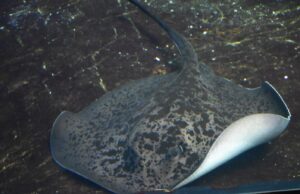
Another common tropical stingray is the black-spotted stingray (Taeniura meyeni), or called the ribbontail ray. It is a stingray that can reach considerable dimensions, up to two meters in width. It is easily recognizable by its colouration: the gray back is dotted with black spots while the belly is white. This stingray does not have a particularly long tail but in any case it is equipped with a poisonous sting. It’s a very curious animal that often approaches humans, it’s not aggressive but you shouldn’t, for any reason, touch it. Usually, it is easily found by night while hunting in the coral reef, while by day it rests on the sandy bottom completely covered by sand for better camouflaging.
The srtingray also commonly found in the Mediterranean Sea, as well as in tropical seas is the Stingray (Trygon pastinaca). This stingray can reach considerable dimensions, up to one and a half meters wide by two and a half meters long. The coloration is dark on the back, varying from grey, brown to olive green; while the belly is clear. The tail is equipped with a serrated and poisonous sting. They can be found during the day while resting under some stones even at shallow depths; or for the lucky ones, hunting during night dives!
Curiosity about stingrays!
In our imagination we have always been used to thinking that stingrays live on the bottom but still at a depth that can be easily observed both by snorkelling and diving. In reality, these beautiful animals have developed particular adaptations in the course of their evolution.
Some species (about 70 known at the moment) are able to survive even at great depths (up to 3000 meters), managing very well all the peculiarities of these places, such as pressure and darkness. This goes to show that these animals are resourceful and very little is known about them yet. Thanks to the curiosity of us divers and the collaboration in research, we will be able to discover more and be even more fascinated by it!

